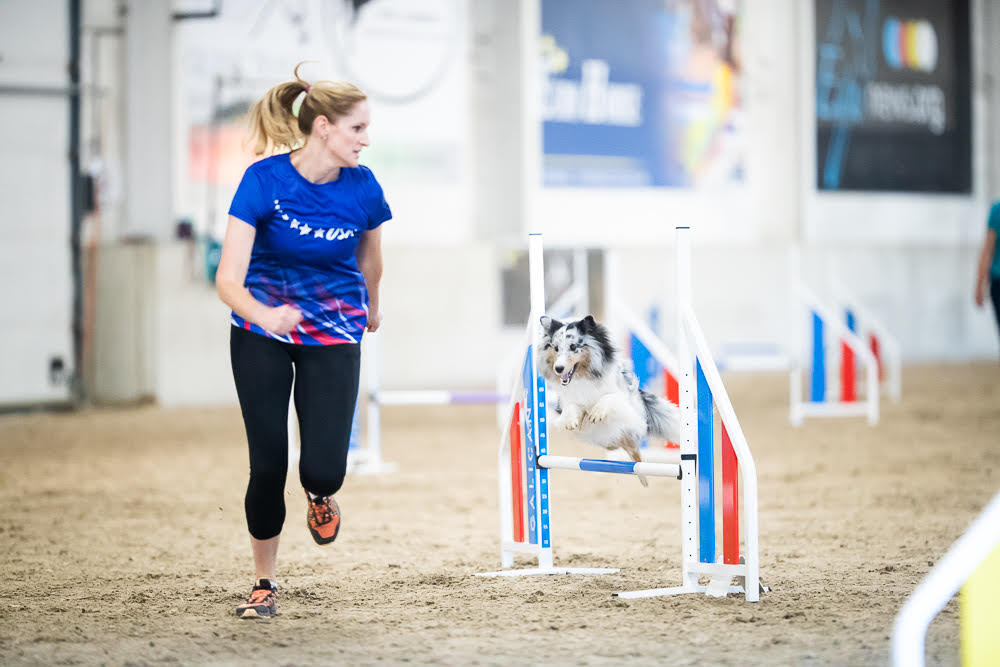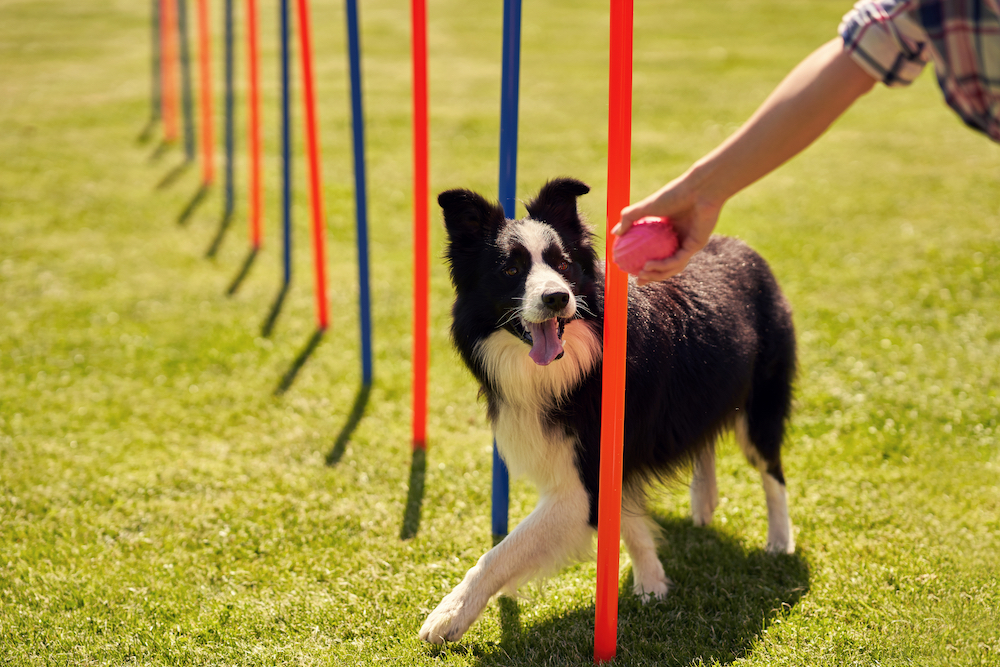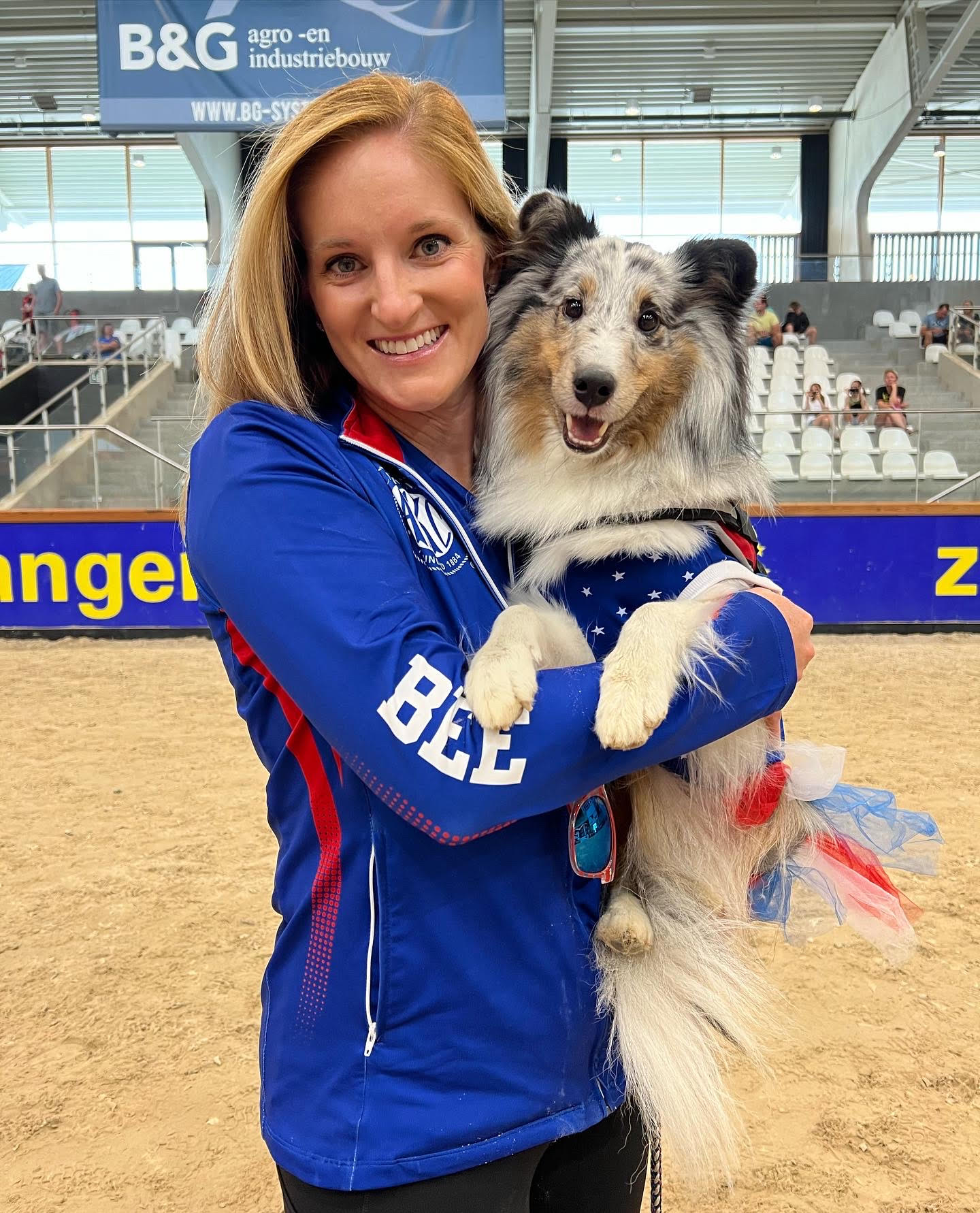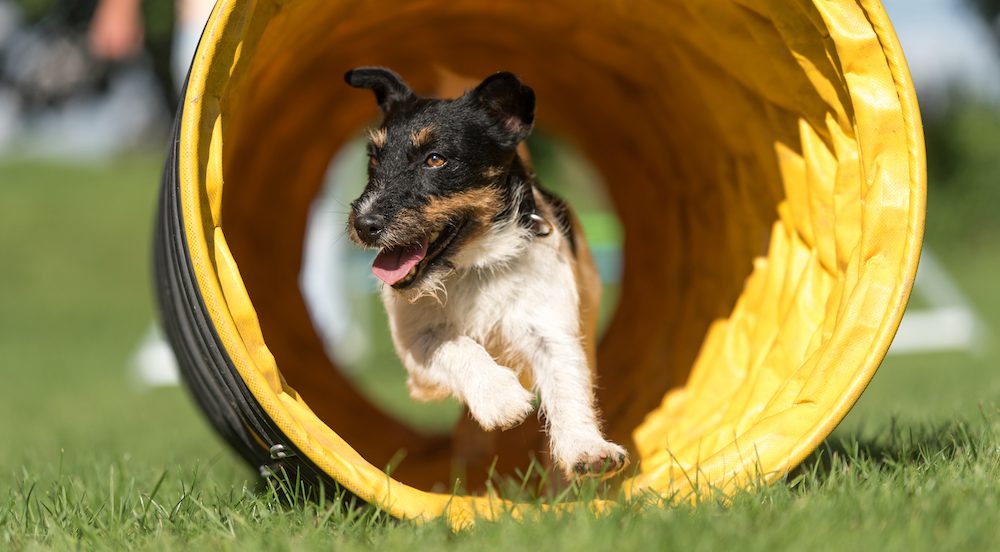Watching a video of Bee’s run at the 2022 AKC Masters Agility Championships, you can see the 3-year-old Sheltie barking with excitement as she zips through a series of intricate obstacles—climbing up and down an A-frame, waiting for a teeter to drop to the floor, navigating the curve of a tunnel, weaving between posts, bounding over hurdles—before finally leaping joyously into the arms of her waiting human. It’s an astounding achievement of athleticism and intelligence, and suggests a strong bond between human and canine. It also looks like a lot of fun.
After we saw what Bee was able to do, we reached out to her handler, Jenn Crank, who runs Bad Dog Agility. In a coincidental bit of “synergy,” Crank also handled Lucky, a winner in the 2022 AKC Agility Dogs Premier Cup—sponsored by The Farmer’s Dog. Here are her pointers on why humans might want to introduce their favorite dogs to the sport, and how to do it.

Bee and Jenn Crank. Photo: Jukka Pätynen / Koirakuvat.fi
Why train your dog in agility?
It’s fun
The best reason to start agility with your dog is the same as the best reason to get a dog in the first place—it could make both of your lives more enjoyable, as illustrated by Bee’s exuberant leap. Dogs need mental and physical exercise as well as quality time with their favorite people; agility checks all of those boxes.
If you do get going on agility, keep in mind that you’re there to have a good time; watch your dog closely to make sure that they’re getting what they need out of it. Crank emphasizes that you can’t force your pup to navigate the obstacles, let alone do so quickly—they have to love what they’re doing.
“When somebody will get frustrated with their dog,” Crank says, “I always look at them and say ‘hey, remember your dog did not drive here to agility class tonight. You drove them. They’re doing this for you. Keep this fun for them, make them want to be out there—because they don’t know they’re running against other dogs, and they don’t know they’re running for ribbons and prizes. They’re just out there to have a good time and hope that at the end of the day mom or dad’s really happy with me when we cross the finish line.”
Motivating dogs to complete these novel tasks involves figuring out what they love and convincing them that, if they give this a shot, they’ll get it.
“Sometimes it takes you thinking outside the box,” says Crank. She says that, for some hunting dogs, a frozen bird wing at the end of a tunnel would do the trick. “I knew one dog,” she remembers, “that would go crazy when their owner would sweep or mop in the house, kind of chasing after the broom—so I told her to bring her broom to class.” No matter what makes your dog tick, getting the best performance out of them means taking their perspective and offering them something they find exciting as a reward.
It’s good physical exercise
If your dog is in good enough physical condition to complete an agility course, it’s a fine way to give them an aerobic workout. Agility asks dogs to run and jump—activities that most pups enjoy, and from which they benefit.
As a bonus, if you’re handling your dog in agility, you’re likely to get exercise too. That’s because you’re an important part of the agility team (more on that later).

Agility training works best when it’s fun for your dog.
It works a dog’s mind, too
Every agility course is a bit different, and your dog can only navigate it with your help. A course can have up to 20 obstacles, and to complete it a dog needs to know how to handle each one and follow their human’s guidance in stringing them together. Common obstacles in agility courses include:
Jumps: These are horizontal poles that dogs must leap over. They’re placed at different heights to accommodate dogs’ varying sizes and ages, so a 12-year-old corgi wouldn’t be expected to make the same leap as a 3-year-old sheltie. That wouldn’t be realistic or safe.
Weave poles: These are vertical poles that dogs zig-zag through.
Teeters, or seesaws: A version of what you’ve seen on children’s playgrounds, these obstacles require dogs to walk from one side to the other, running off after their weight tips the second half of the seesaw to the ground.
A-Frames: Dogs run up and down these triangular obstacles, which have markings to indicate where a dog’s feet must touch to avoid a fault.
Tunnels: Dogs have to enter on one side of these passageways and emerge from the other. In competitions, they’re usually curved.
These examples give you an idea of what agility asks from pups. Any dog who makes it from the beginning to the end of an agility course, no matter how fast they go, will have learned a lot.
And agility may do more than teach your dog to race through a course—it could also help them get better at problem-solving overall.
In a Psychology Today post entitled “Does Training Make Your Dog Smarter?”, which looked into the broader impacts of training dogs for complex tasks including agility, Dr. Stanley Coren discussed a University of Milan study seeming to demonstrate that such dogs were much more successful at challenges that had no direct connection to their training—in this case, opening a box that contained treats. “It appears that simply having a lot of training in other areas,” he wrote, “makes the dogs better problem solvers.”
So a dog with a job like agility may be sharper in various areas of their lives, whether or not they win any ribbons.
It builds your bond
Agility is a team sport. In competition, you and your dog won’t see the course until right before navigating it, and humans only get a short look to get familiar with it before the run. That means your dog will rely on your cues—words and gestures—to know where to go and what to do. As such, success in agility relies on trust between dog and human. A dog has to be so sure that their human is pointing them in the right direction that they’ll go where they’re directed, and do so with joyful abandon.
As such, when asked the secret of elite agility dogs, Crank acknowledges that, as it would be for a human athlete, physical ability is important. But she says the key ingredient is a dog’s desire to work with their human as a team.
“There’s a physical component,” she says of what makes dogs great at agility. “But I find that to be less important than your dog’s desire to be a team player. Technically, we call that ‘biddability.’” She says dogs who seem to have an innate craving to help their people tend to do better.
“I have a border collie who is more athletic and faster than Bee,” Crank says, “but she’s not the team player that Bee is. Bee really looks at me and is like, ‘what can I do to please you?’”
Ethologist Dr. Marc Bekoff, professor emeritus of Ecology and Evolutionary Biology at the University of Colorado, Boulder, stresses the value of cooperation in this endeavor—and how it can enhance your cross-species friendship. Compared to more basic training, he says, the complex series of actions needed to succeed on the course “requires a more developed relationship between the human and the dog.”
Perhaps even more than improved problem-solving ability, a rock-solid bond between human and dog yields dividends far from the course and throughout a pup’s life. A closer relationship with your dog is a reward in itself.
How to get your dog started in agility
Make sure they’re up to it
First things first: it has to be safe for your dog to undertake agility. For all of its benefits, agility is not for every pup. If you have any doubts about whether your dog can safely perform the running, jumping, and side-to-side movements required for agility, talk to your veterinarian beforehand and get their advice.
Though they’re not all destined to be champions, Crank starts all of her pups out in agility. “I want to have the relationship with them,” she says. “I want to give them something to stimulate their minds and give them some exercise—and, as our relationship develops, I can kind of key into how much of a natural they’re going to be on their level of drive, their excitement for agility, and their athletic ability.”
If your dog has conditions that prevent them from navigating certain obstacles or racing through an agility course, they may still be able to learn and complete some of the tasks. And AKC’s Preferred class allows dogs to tackle shorter jumps and take a bit more time to finish a course. Any human can enter their dog into this class if they think it’s a better fit for them.
Even healthy dogs need conditioning, like any athlete, to avoid injury. Crank says that her agility dogs do stretches and warmups—and even undergo massage therapy and acupuncture—in efforts to keep their bodies fresh in the face of agility’s demands.
And, she says, one surprising factor often forces agility dogs to retire from competition: eyesight. “To put a dog really high up if you don’t feel like their vision is 100 percent,” she says, “can be scary.”
Some retired agility dogs go into other organized activities, like scent work. Others may become therapy dogs. Regardless, dogs with a lot of mental energy who aren’t fit for agility can still remain active and retain a sense of purpose.
Practice at home
Before you go to formal training, you can set up certain obstacles in your backyard, a park, or any space you might be able to access.
“When I started,” says Crank, “I put a broom across two paint cans and would jump my dog back and forth across it.” If you’re doing this, start very low—you can even put the broomstick on the ground and have your dog step over it at first.
To train dogs to crawl under things, Crank says, “I’ll tell people to drape a towel or blanket over a chair and see if your dog will walk under it.” How easily dogs take to these tasks, and how much fun both of you are having, can give you some indication of whether you both want to continue with agility or find something else to do.
Another test is to see how your dog might tolerate an obstacle that moves, like a teeter would. “Sometimes,” says Crank, I’ll say ‘if you get access to a playground, walk them across one of those sway bridges.’” If you’re going to do this, pick something you’re sure is safe and low to the ground so that your dog won’t get hurt or upset if it doesn’t go the way you hoped.
Start and end with easier tasks, reward your dog a lot when they get something right, and give them breaks if they’re getting tired—these are guidelines that will help with any kind of training.
“We might do five minutes of stuff that’s running-based,” Crank says of her and Bee. “Then we’ll do something hard, and then we’ll end on the fun stuff as well… I think short sessions and not drilling any one thing for too long keeps it really fun and upbeat for her.”

Courtesy, Jenn Crank
Find a good trainer, and maybe a competition
If you decide that agility is right for you and your dog, you may choose to work with a professional in your area who can help harness their talents. Crank recommends that anyone looking to get further into this activity reference the AKC’s “Get Started” page for tips.
Whether you just build a little obstacle course in your backyard or bring your dog to a competition, remember that agility is first and foremost a fun way for humans and canines to bond and get exercise. If you keep sight of that, you’ll both win no matter how fast they complete a run.
“When we walk out towards the training barn,” Crank says of Bee, “she’ll run up to the door and stand and wait for me like, ‘Are we going in here? This is where all the fun stuff happens.’”









